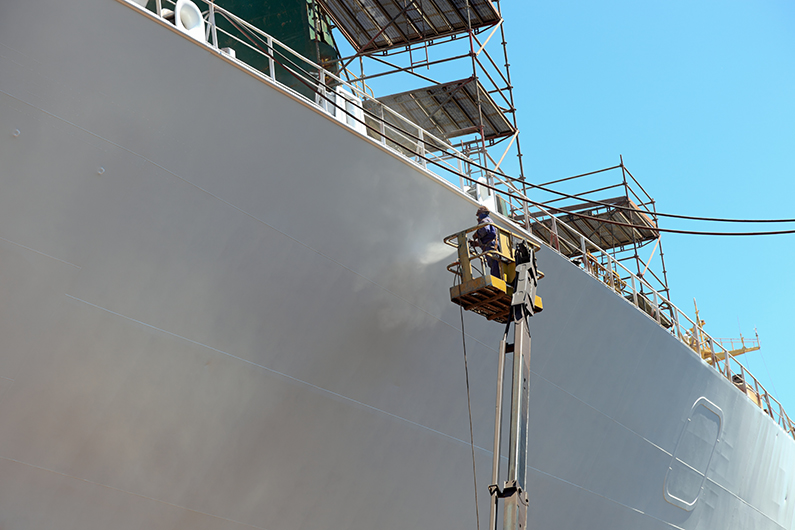More news
- View from the UK: Navigating chemical policy and sustainability
- Focus on adhesives: Unveiling unbreakable bonds – Testing redefines physical strengt...
- Focus on adhesives: Henkel and Covestro collaborate for sustainability of engineered wood ...
- Advances in construction chemical technology: What’s new in 2024?
- Focus on sustainability: PPCJ speaks to BASF Dispersions Asia Pacific about its holistic a...

Jens Kastner reports for PPCJ on the latest innovations in the marine coatings industry
Paint and coating companies worldwide are intensifying innovation as they seek to produce anti-fouling products that are targeted, effective and avoid delivering environmental damage to seas, oceans, rivers and canals.
With sustainability reporting becoming mandatory in the European Union (EU) by 2026 and other countries mulling mandating International Sustainability Standards Board (ISSB) declarations, the pressure to make anti-fouling cleaner is growing. The International Maritime Organisation (IMO) is also pushing for lower emissions from ships – which is impeded by attachment of marine organisms like barnacles and algae to ship hulls, increasing drag and reducing fuel efficiency.
So anti-fouling coatings will become more desirable, especially where they avoid the side effect of also killing those organisms that should not be killed.
There is, as yet, no perfect solution, said Lisa Roepke, a researcher at the Leibniz Centre for Tropical Marine Research (ZMT), in Germany. She told PPCJ: “Marine anti-corrosion, anti-fouling coatings are a very important topic in the scientific discourse, and even though we have been seeing many promising approaches, the holy grail has not yet been found.”
She noted that the use of nanoparticles, copper-based solutions and biocides in anti-fouling coatings comprise “complicated cocktails that are very difficult to test for sustainability in a real environment”.
Roepke added that an innovative approach, covering hulls with foils as opposed to liquid coatings, is struggling to gain traction, as small damages to the foil would require the cumbersome replacement of the entire foil. Meanwhile, novel robots cleaning hulls when ships are in the port still struggle with handling the hulls’ curved surfaces.
“I know that this remains a real challenge for now, but I think it will be overcome technically, eventually,” said Roepke. “However, it remains to be seen if these robots will become an economically feasible solution for ship owners, as the vacuuming of a hull takes time.”
Coatings remain the solution
So, high-tech coatings may still be the solution, with innovators recently focusing on environmentally friendly marine coatings that use silicone to provide an ultra-slippery surface, so that fouling finds it difficult to adhere.
A good example is from US-based PPG, which has been exploring marine coatings that provide sustainability benefits. In March 2023, PPG launched SIGMAGLIDE 2390, a biocide-free fouling release coating using PPG HYDRORESET technology, which modifies the coating when it is immersed in water to create a super-smooth, almost friction-free surface that marine organisms do not recognise and cannot adhere to.
This enables vessels to maintain a clean hull and reduce drag, achieving power savings of up to 20%, a speed loss performance of less than 1%, and up to 35% reduction in CO2 emissions. It makes it easier for owners and operators to meet targets for reduction of greenhouse gas emissions under the IMO energy efficiency (EEXI and EEDI) and carbon intensity indicator (CII) requirements.
PPG claims that SIGMAGLIDE 2390 can deliver up to 150 days of idle performance (when a ship is in port, and not moving and hence more prone to fouling) and an extended lifetime for a ship of more than 10 years with minimal maintenance requirements.
“These benefits provide an industry-leading return on investment for shipowners,” Ariana Psomas, PPG Segment Director new build and dry dock, told PPCJ.
“The coating is also suitable for electrostatic application, which provides high transfer efficiency, leading to lower paint consumption,” she noted [1].
READ MORE:
Germany-based BAJO Coatings GmbH has also developed and sells biocide-free ship coatings. Its customer base is private customers, dealers, yacht owners and boatyards. BAJO currently offers two biocide-free, two-component antifouling products with pronounced amphiphilic properties, which attracts an organism to adhere, but it cannot gain real traction and is then flushed away by the movement of a ship in water as it sails.
At the beginning of 2024, BAJO will launch a new biocide-free, self-polishing, erodible underwater coating, that constantly releases elements into the water, impeding organisms’ ability to stick to the hull, whose performance is comparable to biocide-containing antifouling coatings commonly used today.
“Boat owners are increasingly asking for sustainable coatings because they want to be more environmentally friendly and regulations are constantly tightening,” explained Martin Kaune, Managing Director of BAJO.
“Nevertheless, boat owners have to find a balance between sustainability, ease of processing and good everyday usability, as our coating technology with pronounced hydrophobicity requires the underwater hull to be cleaned on a seasonal basis. Even though these coatings are not much more expensive than their traditional counterparts and have a longer lifespan, hull cleaning can be costly and inconvenient for the owner,” he added [2].
Another innovator is the Netherlands-based Seajet, which offers a Seajet Eco Range of biocide-free antifouling products. Seajet PellerClean is a coating for propellers, stern gear, shafts, rudders and trim tabs. This foul release product is environmentally friendly, biocide free and provides long term protection against fouling in both fresh and saltwater environments. Seajet PellerClean is suitable for motorboats and sailing yachts up to 30 knots, with a two-part primer for improving adhesion and a silicon topcoat delivering an ultra-slippery surface for releasing any attached fouling. After application, any accumulated fouling normally washes off the non-stick, slippery surface when underway.
READ MORE:
Focus on marine: Hempel dives into sustainability collaboration
“For inactive boats, or those cruising below 5 knots, a quick wash or sponge off will remove any fouling and make the coating look like new again,” Seajet said in a note sent to PPCJ [3].
Meanwhile, Germany-based Wacker Chemie, a chemicals manufacturer that supplies ingredients for maritime coatings, supplies special raw materials such as siloxane polymers, for fouling release coatings.
“Fouling release coatings currently still have a relatively small market share but are enjoying increasing demand,” a company spokesman told PPCJ. “They enable the formulation of coatings that create extremely smooth surfaces and therefore reliably protect against algae and vermin infestation.” [4]
With sustainable antifouling coating demand rising, more paint manufacturer suppliers can be expected to develop such innovative inputs.
References
1- https://www.ppgpmc.com/products/SIGMAGLIDE-2390







